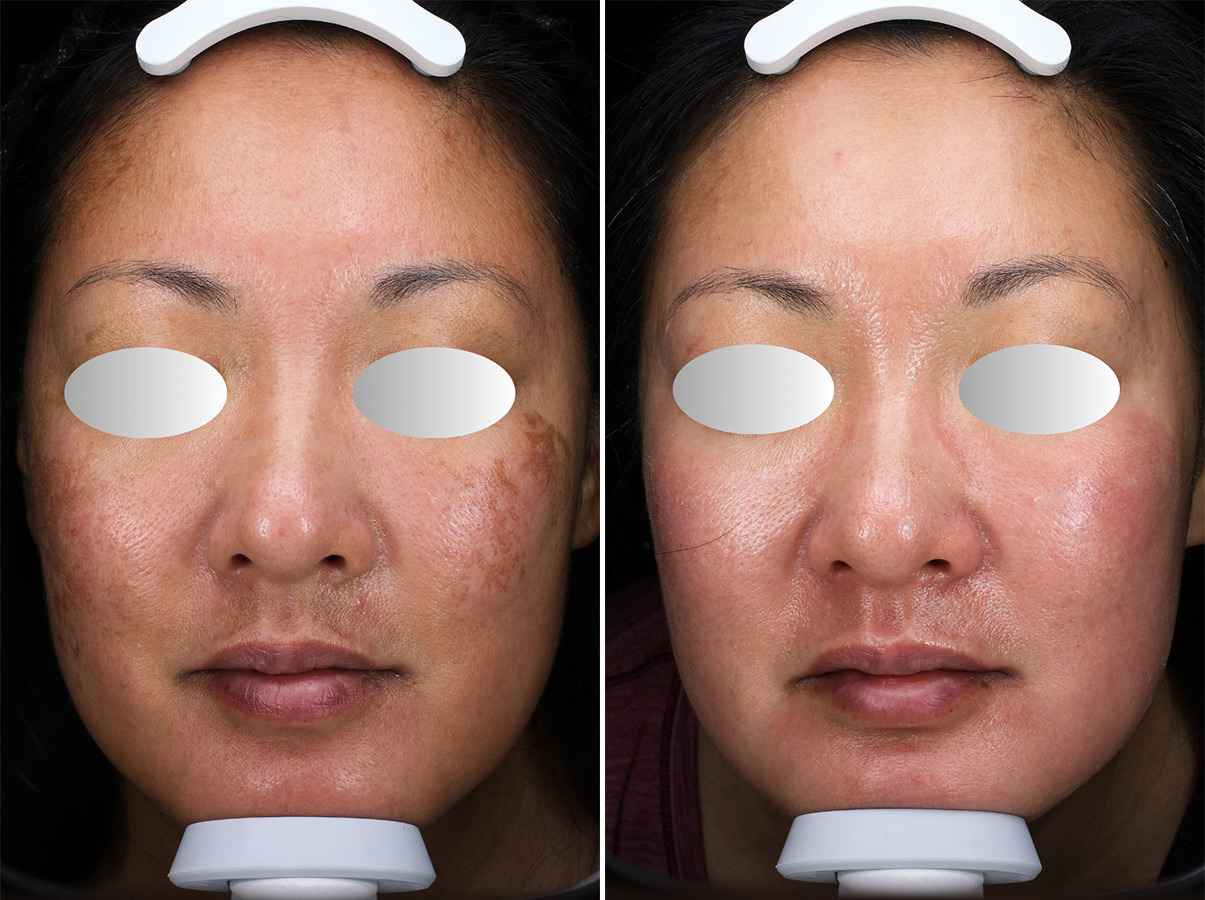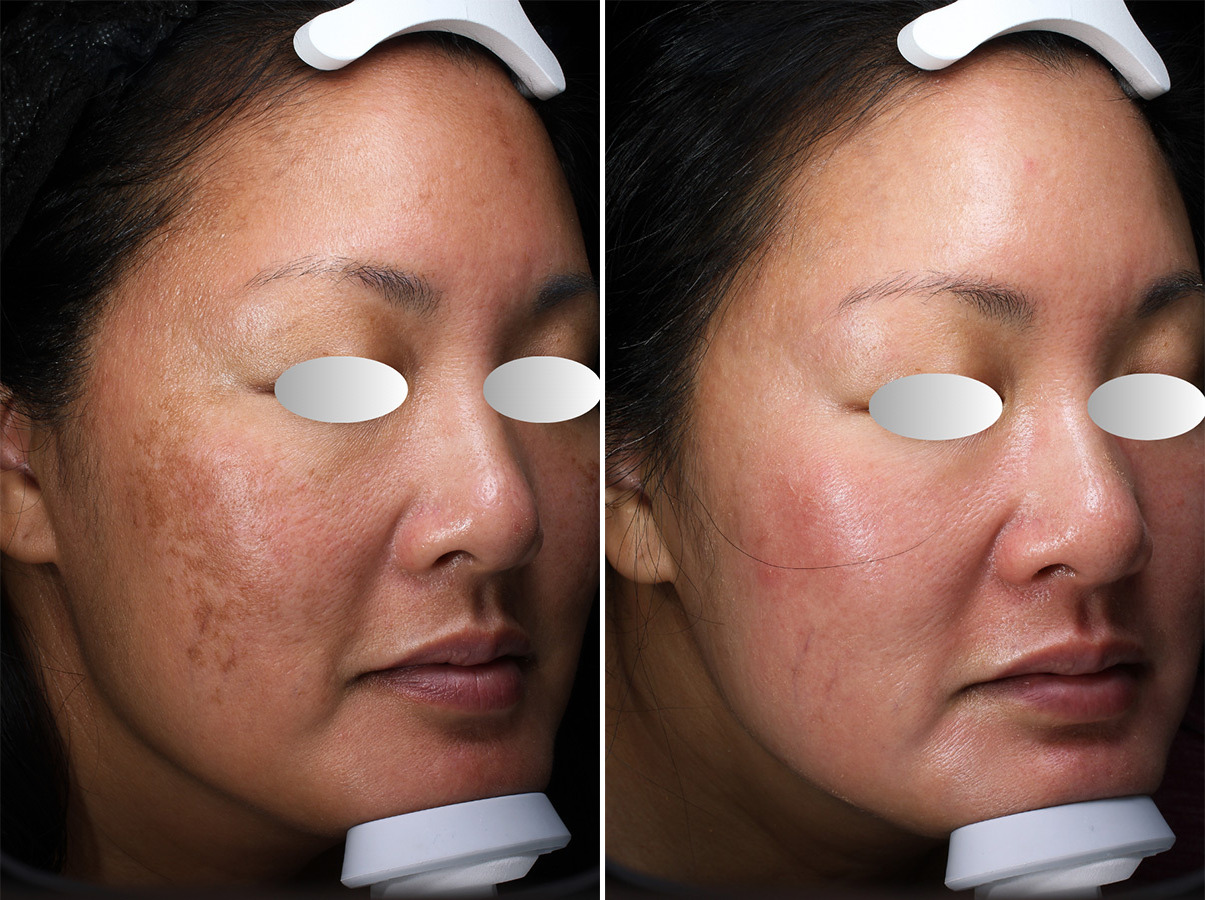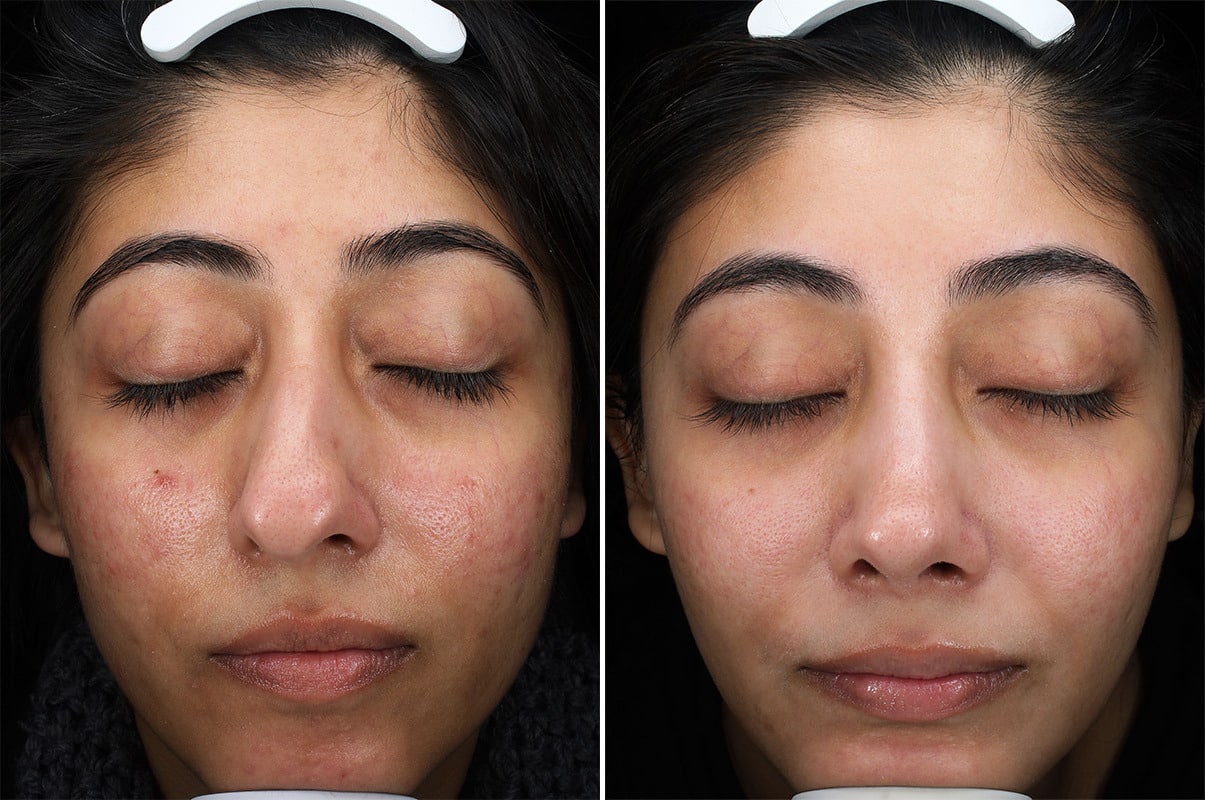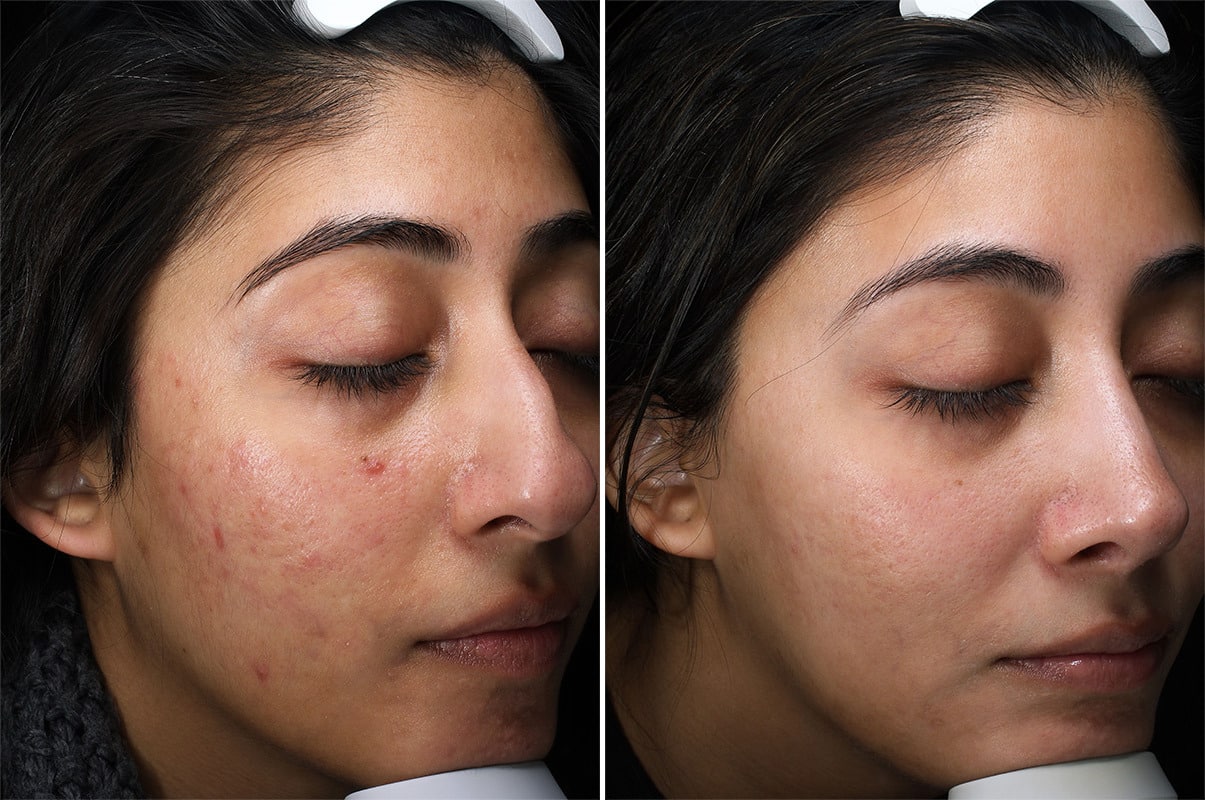Chemical Peels in Virginia, Washington D.C. and Maryland.
Embark on a journey of aesthetic excellence with The Naderi Center. Experience unparalleled artistry and precision for transformative beauty.
Discover Chemical Peels Benefits
Unlock a world of skin transformation with Chemical Peels. Tailored to your unique needs, our treatment offers a range of benefits that go beyond mere surface-level improvements. From rejuvenating your complexion to tackling stubborn imperfections, it’s time to reveal the skin you’ve always desired.
Skin Rejuvenation
Unveil a fresher, younger-looking you. Chemical peels remove dead skin cells, revealing a revitalized complexion underneath.
Acne and Scar Reduction
Say goodbye to stubborn acne and scars. A chemical peel can dramatically reduce skin imperfections, allowing you to put your best face forward.
Improved Skin Texture
Enjoy smoother, softer skin like never before. Chemical peels improve texture and tone, making your skin feel as good as it looks.


What is Chemical Peels?
A chemical peel is a cosmetic skin-resurfacing procedure with a wide range of aesthetic benefits that removes the outer layers of skin through exfoliation to allow the growth of new skin cells. Chemical peels can improve the appearance of skin on the face, neck and upper chest or décolletage. Depending on the strength and depth of the chemical peel, a variety of skin concerns may be improved including coarseness, dullness, hyper-pigmentation, acne and/or acne scaring, sun-damage, wrinkles, and fine lines. By removing dead skin cells on the skin, daily skin-care products will also perform better. Overall, chemical peels will help create a more youthful, refreshed, and energetic look and feel.
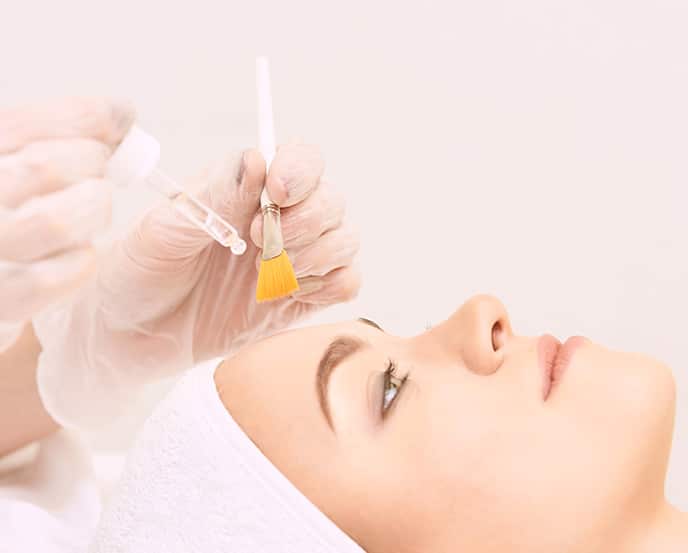
Expected Results after a Chemical Peel
- Rejuvenation of aging skin
- Improvement and prevention of acne
- Treatment of unwanted pigmentation, tone, and texture
- Treatment of pre-malignant lesions
Before Chemical Peel Treatment: Meet your skin
Covering the entire body, the skin is the largest vital organ with an average weight of about 6 pounds. The skin is highly exposed to damage and the structural features of the skin serve as the main outer protective covering of the body to protect again heat, light, injury, and infection. There are two main layers of the skin, the epidermis and dermis, as well as a third layer of fatty subcutaneous tissue called the hypodermis.
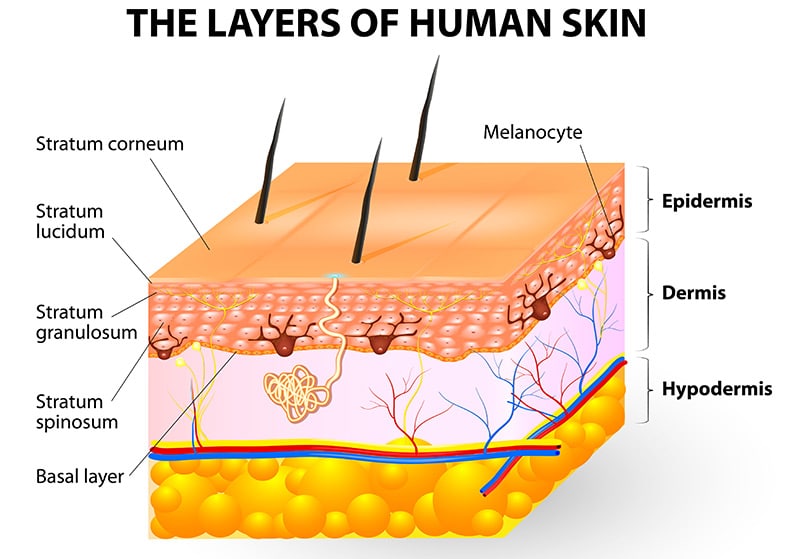
Epidermis
4 Parts of the Epidermis
- Stratum basale (basal layer): Deepest layer of epidermis where fresh, new skin cells are produced.
- Stratum spinosum: Newly formed skin cells are pushed up from the basal layer into the stratum spinosum.
- Stratum granulosum: Transition layer between the new skin cells and the old, flattened skin cells.
- Stratum corneum: Oldest and flattened skin cell layer that is continuously being shed. This layer completely replaces itself every 4 weeks.
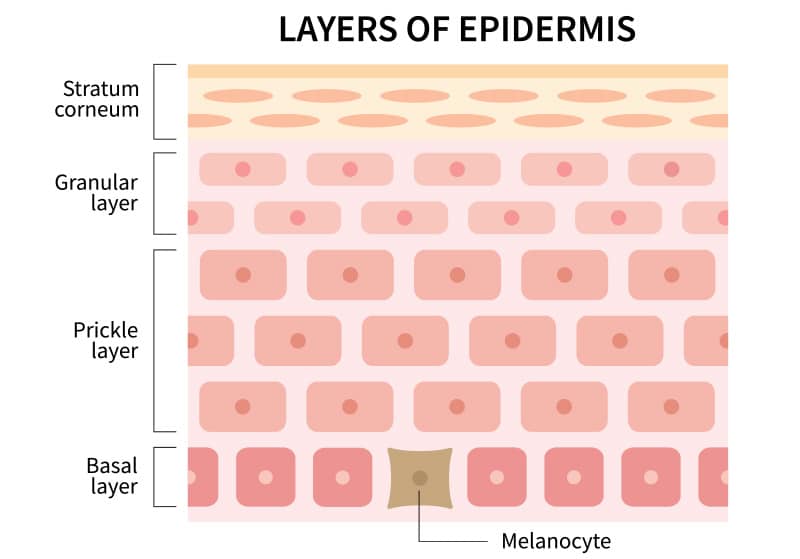
Dermis
The dermis lies below the epidermis and is the thickest layer of the skin consisting of tough connective tissue.
2 Parts of the Dermis
- Papillary region: The superficial portion of dermis containing capillaries and free nerve endings
- Reticular region: The deeper portion of dermis containing nerves, blood vessels, hair follicles, and skin glands.

Ideal Candidates for Chemical Peel
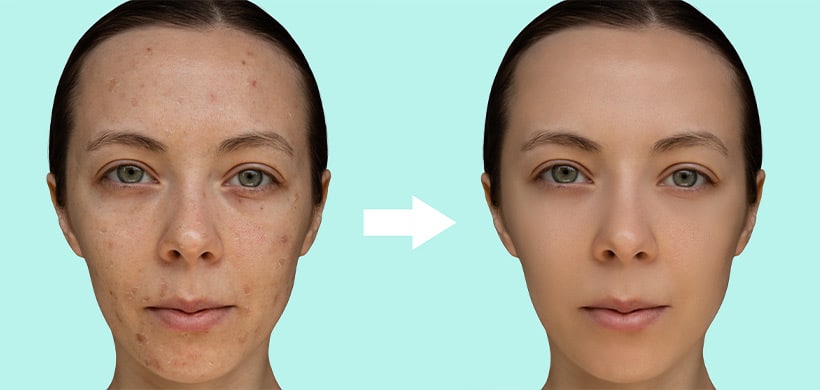
- With pigmentation disorders such as melasma, freckles and sunspots
- Seeking treatment for inflammatory conditions such as acne and rosacea
- Wanting to improve skin appearance due to scarring secondary to acne, trauma or previous surgery
- With a desire to reverse signs of aging including superficial and deep lines, fine wrinkles and photo-damage
- Seeking to treat pre-cancerous lesions such as actinic keratosis
Chemical Peel Techniques
There are several types of chemical peels that address different skin depths depending on aesthetic concerns and goals. Chemical peels range in strength from superficial to deep. The type, strength, and acidic PH content of chemical solution determine whether the chemical peel should be safely performed by a physician or a aesthetician. Your provider will analyze your skin type and skin concerns to determine which chemical peel is appropriate and safe for your skin. It is extremely important to go to a reputable and experienced provider when undergoing moderate to deep chemical peels as risks and potential for severe complications are much higher.
Mild (Superficial) Peel or “Lunchtime Peel”
The mild or superficial chemical peel is the gentlest and least invasive type of chemical peel, ideally used for reducing the effects of mild sun damage, improving acne scarring, and diminishing signs of aging. The outermost layer (stratum corneum) to the innermost (stratum basale) the epidermis can be removed using a superficial peel depending on the product used. Alpha hydroxyl acids (AHAs) such as glycolic acid or lactic acid, beta hydroxyl acids (BHAs), or simple fruit enzymes are used to remove the outermost epidermal layer of skin cells in about 15 to 20 minutes.
Mild chemical peels can be used on the face, neck, and/or chest every few weeks to boot skin appearance or jumpstart a new skincare routine and can also be used to prepare the skin for deeper peels. A superficial chemical peel is great for busy people looking for fresh, glowing skin as the treatment provides significant results with minimal downtime ranging from 5-10 days for most patients. A mild chemical peel works to remove dead skin cells and regenerate new healthy skin cells without the traditional flaking, redness, and discomfort associated with a more intense chemical peel.
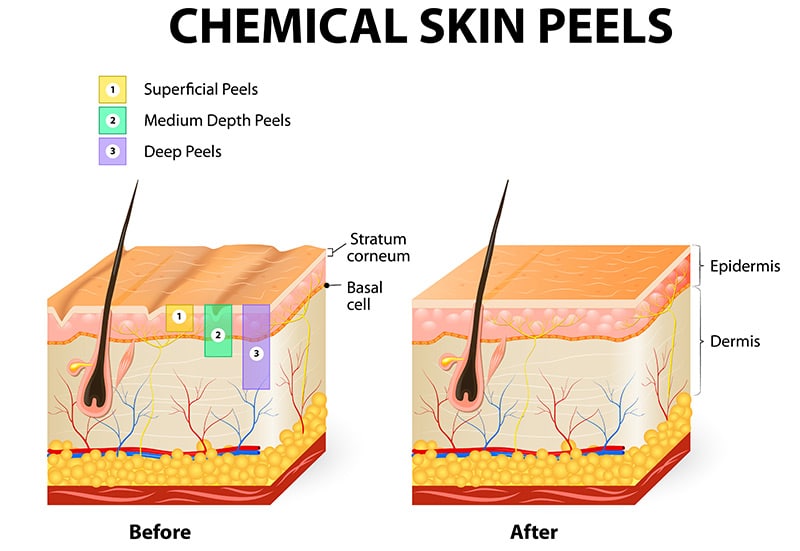
The process for a mild superficial peel begins with a thorough cleansing of treatment area using alcohol. The peel is then applied using a brush, pad, or cotton swap for an appropriate length of time. Once the peel is applied, the patient might feel a mild tingling sensation that lasts for the length of the treatment. The skin may look slightly sunburned once the peel is removed and neutralized, but not significant enough to take time off from work.
The best results for a mild chemical peel are seen with regular treatments. A more minimized appearance of fine wrinkles and uneven pigmentation occurs after repeated peels. This light strength peel is safe for people of any skin color. However, those who are pregnant, have active cold sores, infections, allergies to peels, or are currently taking Accutane (an acne medication) should wait to have a chemical peel.
Typical Chemicals Used for Mild Chemical Peels
- 30-50% Glycolic acid
- 10-30% Lactic acid
- 40% Mandelic acid
- 30% Beta-hydroxy salicylic acid
- Acne prone skin will benefit from this peel and it is capable of efficiently penetrating skin layers
- Days to peeling: 3 – 5
- 50% Alpha-keto pyruvic acid
- Similar properties to salicylic acid & glycolic acid where concerns with photoaging and acne can be addressed.
Mild-Medium Strength Peels
Vi (Vitalize) Peels
The vitalize or Vi peel is a gentle, yet powerful chemical peel used to reduce pore size, treat acne and acne scarring, smooth ruddy complexions, oil-balancing, minimize fine lines and wrinkles, and for overall skin health. While a Vi peel is more powerful than a mild superficial peel, this type of peel promotes exfoliation of the epidermis and collagen synthesis without the downtime of a strong peel. The Vi Peel is safe for all skin types and colors and is one of the only peels on the market safe for use in the under-eye area. The Vi Peel uses a formula blend of trichloroacetic acid (TCA), tretinoic acid, salicylic acid, phenol, Vitamin C, and other minerals to safely remove damaged layers of the skin to provide a more youthful and radiant appearance in just one week.
The Vi Peel is painless for most patients. The process begins with a cleansing of the treatment area. The peel solution is then applied evenly to the skin in 2 phases:
Phase 1: Penetrates into epidermal skin cells
Phase 2: Penetrates deeper into the dermis layer to attack toxins and dead skin cells
Once the Vi Peel solution dries, the patient can resume daily activities, but must wait 5 hours before washing the treatment area. Vi Peels can cause redness and peeling similar to a severe sun burn appearance for about 5 days after treatment.
Vi Precision Peel
The Vi Precision Peel is 25% stronger than regular Vi Peel and is recommended for patients desiring a more significant peel outcome than a regular Vi Peel.
Jessner Solution
The Jessner solution is a leave-in solution that only affects the upper dermis and is self-neutralizing. Takes about 7 to 8 days to complete the peeling process. Ingredients include salicylic acid, lactic acid, and resorcinol in an ethanol base.
Obagi Blue Peel/10% to 20% Trichloroacetic acid (TCA) Peel
The Obagi Blue Peel is a proprietary chemical peel based on active ingredient trichloroacetic acid in varying concentrations of 10%, 15% and 20%.
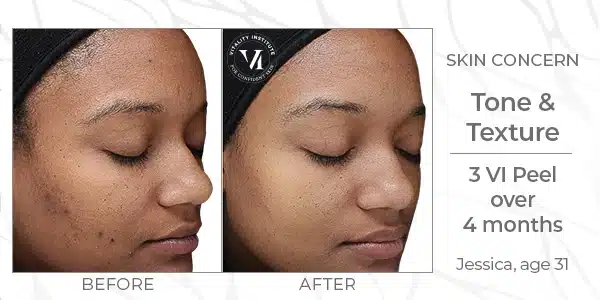
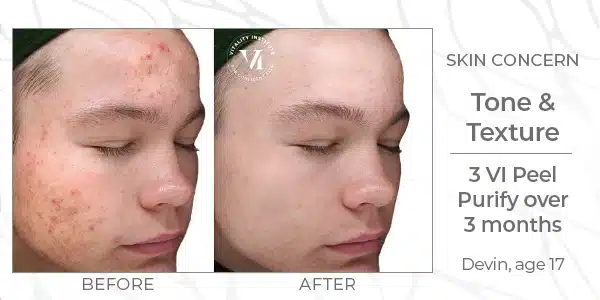
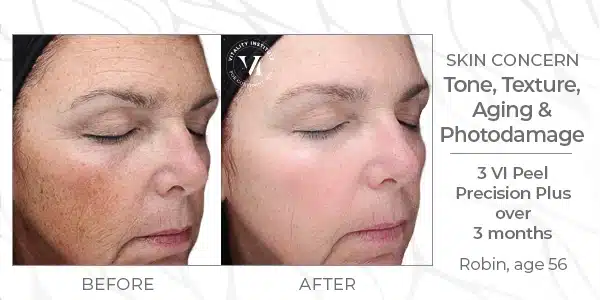
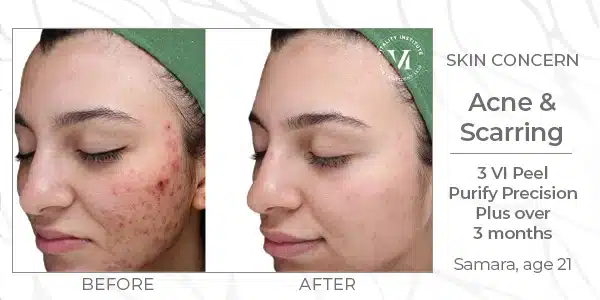
Medium-Strength Peels
Medium-strength or TCA chemical peels are used to create a more youthful skin texture by improving uneven skin pigmentation and texture using a trichloroacetic acid (TCA) in combination with glycolic acid. At concentrations of 20-50%, TCA peels are able to penetrate the superficial epidermis of the skin and reach the uppermost layer of the dermis, the papillary layer. The appearance of aging, skin discoloration, sun-damage, scarring, and some precancerous skin growths can be reduced depending on the intensity of the chemical peel concentration. TCA chemical peels are also great for patients looking to get rid of acne once and for all.
The results of a medium strength peel can be improved by pretreating with a mild or superficial peel. Medium-strength chemical peels are ideal for a patient who is looking for a more noticeable result than a superficial chemical peel but does not want the risk and recovery time associated with a deeper chemical peel. Medium-strength chemical peels can be applied to the skin up to 4 times a year with expected downtime lasting up to 10-14 days for most patients.
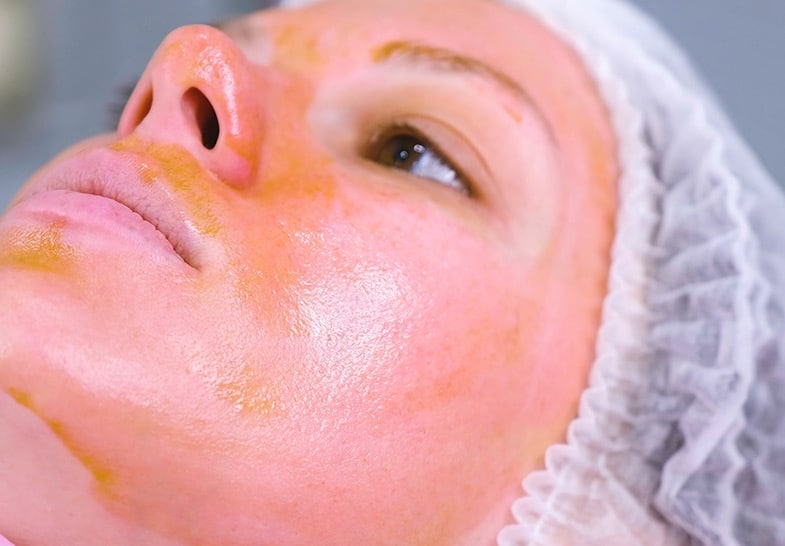
Medium strength chemical peels can be safely performed on patients with olive to light brown skin tones. For patients with dark brown skin tones, there is slight risk of discoloration, which will be discussed with your provider. It is recommended for patients to apply a retin-A cream to the skin daily for up to 4 to 6 weeks prior to a medium-strength peel to help speed the exfoliation process and growth of new skin cells as well as provide a deeper penetration of the peel. Since this is a medium depth peel, the skin will be red and swollen after treatment. The skin may for blisters as the skin crusts and peels off in 1 to 2 weeks post treatment.
The process for medium-strength peel begins with a thorough cleansing of treatment area and numbing. The peel is then applied using gauze, a small brush, or cotton tipped applicator for an appropriate length of time. Your provider will observe the chemical changes to the skin as the treatment area is exfoliated. You may feel an intense burning sensation while the peeling agent is applied and saturating into the skin. After around 15 minutes once the solution has been fully saturated, the solution will be neutralized using iced saline to stop the chemical exfoliation process and then removed. The treatment area will then be covered in a soothing ointment to keep the skin moist, promote healing, and aid discomfort. Sedatives or pain pills may be offered to a patient to tolerate discomfort. Medium-strength chemical peels can be applied to the skin up to 4 times a year with expected downtime lasting up to 10-14 days for most patients.
Deep-Strength Chemical Peels
Deep-strength chemical peels are the strongest type of chemical peels available used for intense skin exfoliation to penetrate the deepest layer of the dermis, the reticular dermis. Since deep chemical peels reach the reticular dermis layer, these types of chemical peels have the most dramatic effects on severe wrinkles and discoloration.
The main active ingredient used in a deep peel is phenol up to 88%. Another common ingredient used in deep peels is croton oil that is mixed with phenol. A high percentage TCA solution can also be used for a deep strength chemical peel. Previously, the Baker-Gordon formula was the standard for a deep chemical peel agent, but this has been replaced by deep strength TCA and phenol/croton oil peels.
Deep chemical peels create a youthful skin texture and can change the appearance of severe wrinkles, sun-damage, skin discoloration, brown spots, scarring, and some precancerous skin growths like actinic keratosis. Deep peels improve the quality of environmentally damaged skin, something a face lift cannot do. A deep strength chemical peel is great for a patient looking for longevity with a peel.
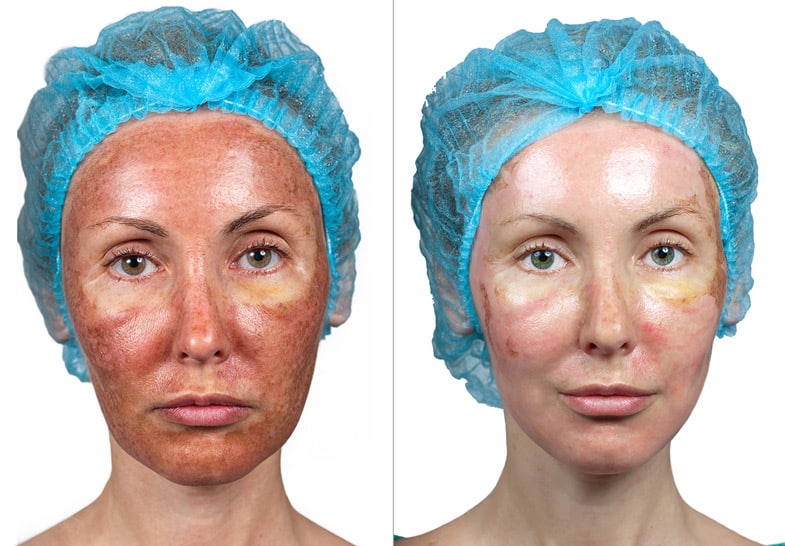
The results of a deep chemical peel can last for years; however, the treatment can only be performed once and only used on the face. Most patients have a superficial chemical peel prior to deep chemical peel treatment to prepare the skin and to allow for a deeper penetration of peeling agents.
Due to the strength of the peel, a deep chemical peel is performed with an experienced board-certified surgeon under sedation and anesthesia. The process for a deep chemical peel will begin like most other peels with the skin pretreated and cleansed.
The peeling solution is then brushed onto the skin and observed for chemical changes. It is normal for the peeling solution to turn the skin one to two shades lighter in color much like a deep CO2 Laser, due to the bleaching effect it has on the skin. The treatment will be complete after a few minutes and the solution will then be neutralized and removed from the skin. A soothing ointment will be placed onto the skin to promote healing and reduce discomfort.
The face also may be wrapped in a protective garment. Pain medication can be prescribed for the first several days of recovery. Down time associated with this peel is about 14 day due to crusting and post-procedure redness, but the skin will need to continue to heal over the next couple of months. A deep strength peel is not recommended for someone with heart problems or for freckled or dark-skinned patients due to the bleaching nature of the process.
Chemical Peel Treatment: What is Frosting?
Frosting is a chemical reaction where the skin begins to turn white following application of a chemical peel, due to melanin suppression, creating a risk for burn and/or hyperpigmentation during recovery. For patients with dark brown to black skin towns, there is slight risk of discoloration with a medium strength chemical peel which will be discussed with your provider. However, deep strength chemical peels are not as recommended for patients with dark brown to black skin tones due to a high potential for scarring and post-peel cracking.
It is recommended for patients to apply a retin-A cream to the skin daily for up to 4 to 6 weeks prior and after a medium-strength or deep-strength peel to help speed the exfoliation process and growth of new skin cells as well as provide a deeper penetration of the peel.
Chemical Peel Pricing
| Jessner Peel: | $375 |
| TCA Chemical Peel (Various Concentrations—Can be a spot treatment or full face): | $150-1800 |
| VI Peel: | |
| o Standard VI Peel: | $375 |
| o VI Purify | $425 |
| o VI Precision Plus | $425 |
| o VI Precision Purify | $475 |
| Deep Chemical Peel: | $4,800-6,000 |
Preparing for a Chemical Peel
In order to optimize results after a chemical peel there are a few things that patients can do to improve results. The first is to avoid sun exposure leading up to the day of their peel, skin that is tanned or sunburnt will not heal well and your procedure may be cancelled. Additionally, your provider may pre-treat your skin for a few weeks with skin lighteners and tretinoins to prevent hyperpigmentation and promote healing. It is also important to avoid any harsh skin care products in the days leading up to your peel so that your skin is not irritated. It is recommended that you do not apply makeup on the day of your treatment and come with clean skin.
Recovery After Chemical Peel
Below are general instructions that should be followed after a moderate to deep chemical peel. Mild to superficial peels generally require minimal post-recovery, which includes avoiding sun exposure and following a post-treatment skincare regiment.
Day Of Chemical Peel Procedure
- Sleep: Sleep on your back with your head elevated about 30-40 degrees (2-3 pillows).
- Do not sleep on your side. Keeping your body more upright will minimize swelling. You do not want the chemically treated areas to be pressing against your pillow. Continue this for one week.
- Post Recovery Ointment: After treatment we will apply a post recovery ointment to the skin. Make sure to keep your face covered with a thick layer of this ointment during the recovery period after a chemical peel. This ointment will prevent the skin from drying out and crusting.
Medications After Chemical Peel Procedure
- Pain: Depending on the type of chemical peel performed, you will be prescribed a pain medication for post-operative pain control. If your discomfort after treatment is not strong you are welcomed to take Tylenol in place of the prescribed medication. Do not take Tylenol with the pain medication, often the medication you are prescribed will have Tylenol in it. Do not exceed 4,000 mg of Tylenol in any 24-hour period. Take medication with food to minimize risk of nausea.
- Nausea: If you are experiencing nausea, which is common after general anesthesia as well as a known side effect of some stronger pain medications, we advise that you take your nausea medication.
- Constipation: You will experience constipation if taking narcotic pain relievers. MiraLAX or other over the counter laxatives are recommended. Do not wait to take until you are constipated.
- Medications to Avoid: Take only those medications approved or prescribed by your surgeon.
Nutrition After Chemical Peel Procedure
- Diet: A light low-fat diet is best after surgery. You may start a regular diet the day after surgery if you are not feeling nauseous or vomiting. Start with liquids for the first few hours after surgery and then slowly advance to more solid foods.
- Hydration: Stay hydrated by drinking 8 -10 glasses of water a day. Avoid alcohol for 48 hours while you are still taking pain medications.
Activity After Chemical Peel Procedure
- Sun Exposure: Strict sun avoidance for the first eight weeks after treatment. You will burn and discolor the skin if you have direct sun exposure. If you must go outside apply sunscreen with minimum of SPF 30, wear a wide brim hat, sunglasses, and stay in the shade.
- Return to work: Most patients require approximately 5-7days off work depending on their job responsibilities and face-to-face interactions.
- Driving: You will need someone to drive you home following treatment. Do NOT operate a vehicle or make important decisions until you have been off pain medications for 24 hours. Use good judgment.
- Exercise: Light physical activity may be resumed 1-2 weeks after the procedure. Remember to start easy and build back up to your previous exercise levels. Just know that swelling may transiently be worse with exercise.
- Activity: Saunas, hot showers, and hot tubs should be avoided for 2 weeks. These activities may further irritate the skin and delay proper healing.
- Pain Management: Cool compresses with a damp soft cloth for 10-20 minutes at a time may relieve temporary discomfort.
Bathing After Chemical Peel Procedure
- Showering: You may shower and wash your hair normally after 48 hours. Make sure to avoid getting soap or shampoo on your healing face. Always apply your post recovery ointment immediately after you get out.
- Wash Your Face: Skin should be washed 4-6 times a day with only cool tap water and soft cotton balls for the first 3-4 days after the procedure. DO NOT USE ANY CLEANSERS, SOAPS, OR TONERS for the first 4 days. After you have cleansed the skin with cool water apply a thick layer of your post recovery ointment. Once the skin starts to heal after about day four and when advised by your surgeon, you may start to use a gentle cleanser such as Cetaphil
- Skin Repair Kit: At your follow up appointment, one week after your procedure you will be given a skin repair kit. Please follow the instructions to optimize the benefits achieved from using the skin repair kit.
What to avoid during Chemical Peel Recovery
- You must not pick or rub your skin.
- Do not go out in the sun at all while peeling – even 5 minutes. After the peel, wear sunscreen daily.
- Do not use any creams (such as bleaching creams, Retin-A, or glycolic acid) until the doctor instructs you to do so.
- Do not apply ice or ice water to the treated areas. Vinegar soaks may be used if needed.
- Do not put the face directly into a hot shower spray. Do not use a steam room, Jacuzzi, or sauna.
- Do not go swimming.
- Do not participate in activities that would cause excessive perspiration.
- Do not use any means of mechanical exfoliation.
- Do not direct a hairdryer onto treated areas.
Recovery Expectations after a Chemical Peel
Superficial Peels
What to expect?
- You will be pink for the first few days, followed by light flaking or peeling for 3–4 days
Recovery instructions after superficial peel
- Lotion or cream should be applied until the skin heals, followed by daily use of sunscreen
- Makeup can usually be worn the next day
Medium Peels
What to expect?
- Facial edema or swelling begins shortly after the procedure and peaks at 24–48 h.
- Eyelids may swell shut
- Areas that have been treated may have a slightly yellow appearance, red, and/or swollen
- There may be a progressive darkening and tightening of their skin into a mask-like appearance. There should be no associated pain.
- Blisters may form and break
- After 4–5 days, the skin will proceed to come off in thick sheets, like a snake shedding its skin
- Papillary dermis peels should heal in 7 days, while peels reaching the superficial reticular dermis will take up to 14 days to heal.
Recovery Instructions after medium strength peel
- Skin must be soaked daily for a specified period, followed by ointment application
- Antiviral medication is taken for 10 to 14 days
- Mild lotion or cream may be applied
- Avoid all sun exposure until healing is complete
- Camouflage makeup may be worn after five to seven days
- A follow-up appointment will be necessary to monitor progress
Deep Peels
What to expect?
- Swelling: Swelling of the face and/or eyes is common, and typically begins to reduce by the third day after treatment and may improve with intermittent rest. Physical activity can transiently worsen swelling but is encouraged.
- Pinpoint bleeding: Pinpoint bleeding may occur but will stop after the first 24 hours. This is normal. Variable redness, streaking, or splotches may appear. This is nothing to be concerned about as it just reflects variation in healing.
- Itching: Itching at the chemical peel areas is normal for the first few weeks. You may take Benadryl to help reducing the itching sensation.
- Oozing: Oozing is common and generally looks like yellowish drips on the skin. Blot these areas gently with a soft tissue and reapply the ointment as needed.
- Discomfort: It is normal to experience tightness, soreness, and fatigue for several days to weeks following your procedure as your skin recovers.
- Burning: Burning, hotness, redness, warmth, and a sunburned sensation are normal and anticipated responses following your chemical peel. Adequate cleansing and liberal moisture will minimize these sensations as well as skin flakiness and peeling.
- Milia: Occasionally small white bumps called “milia” may appear. Milia typically resolve on their own without any treatment.
Recovery Instructions after Deep Peel
- The treated area will be bandaged
- Skin must be soaked four to six times daily, followed by ointment application for the first 14 days
- Afterwards a thick moisturizer is applied for the next 14 days
- Antiviral medication is taken for 10 to 14 days
- Mild lotion or cream may be applied
- Avoid all sun exposure for three to six months
- Camouflage makeup may be worn after 14 days
- Several follow-up appointments will be necessary to monitor progress
Testimonial
“Great place to go for cosmetic repair etc. It is a beautiful office and very clean! Their aesthetician was excellent. She has a very kind caring bedside manner. Everyone in the office is friendly and you feel welcome.”
Real Patient
Safety, Risks and Potential Complications after Chemical Peel
Contraindications for All Chemical Peels
- Bacterial, viral, or fungal infections
- Open wounds
- Pregnancy
- Breastfeeding
- Use of photosensitizing drugs
- Presence of inflammatory skin diseases
Potential complications after a chemical peel
It is extremely important to have your chemical peel performed by a practitioner that understands chemical peels and specifically which peels are appropriate for what skin types and conditions. The gravity of complications significantly increases with the increasing strength of the peel. Deep chemical peels should never be performed by non-medical providers.
Superficial Peels
- Excessive burning
- Premature Peeling
- Associated with an increased risk of several side effects such as infection, persistent erythema, post inflammatory hyperpigmentation, and scarring.
- It may occur accidentally or by manipulation of peeled skin (e.g., picking at the treated skin).
- Early and aggressive therapy with oral antibiotic is recommended until complete re-epithelialization.
- Persistent Erythema
- Erythema lasting longer than 3 weeks after the peeling may be a sign of an impending hypertrophic scarring.
- A therapy with highly potent topical corticosteroids (class 1) for about 2 weeks is recommended.
- Post inflammatory changes in skin color
- Redness
- Itchiness
Medium Depth Peels
- Excessive burning
- Post inflammatory changes in skin color
- Infection
- Bacterial infections can irritate normal wound healing and lead to scar formation
- Appropriate antibiotic regimen should be immediately started and continued for a 7-day to 10-day course.
- Herpetic viral infections can be problematic for a patient’s natural recovery.
- Regimen course of valacyclovir should be used
- Scarring
- Risk of scarring can be reduced with appropriate priming or prepeel treatment, the right choice of exfoliating agents, and appropriate follow-up treatment and care.
- Particularly at risk are patients with a history of poor wound healing, hypertrophic scars and keloids, a recent therapy with isotretinoin in the last 1–2 months, infection in the treatment area, deep peels, or too short of a time interval between peels, or a peel that is performed too soon after surgery in the treatment area.
- Premature Peeling
- Associated with an increased risk of several side effects such as infection, persistent erythema, post inflammatory hyperpigmentation, and scarring.
- It may occur accidentally or by manipulation of peeled skin (e.g., picking at the treated skin).
- Early and aggressive therapy with oral antibiotic is recommended until complete re-epithelialization.
- Acneiform eruptions
- May present as multiple erythematous follicular papules and may occur during or shortly after the peel.
- They are treated with oral antibiotics, commonly used in the treatment of acne.
- Persistent Erythema
- Erythema lasting longer than 3 weeks after the peeling may be a sign of an impending hypertrophic scarring.
- A therapy with highly potent topical corticosteroids (class 1) for about 2 weeks is recommended.
- Milia
- tiny white cysts
- Delayed Wound Healing
- Herpes outbreak
Deep Chemical Peels
- Post inflammatory changes in skin color
- Infection: Bacterial infections can irritate normal wound healing and lead to scar formation
- Appropriate antibiotic regimen should be immediately started and continued for a 7-day to 10-day course.
- Herpetic viral infections can be problematic for a patient’s natural recovery.
- Regimen course of valacyclovir should be used
- Scarring
- Risk of scarring can be reduced with appropriate priming or prepeel treatment, the right choice of exfoliating agents, and appropriate follow-up treatment and care.
- Particularly at risk are patients with a history of poor wound healing, hypertrophic scars and keloids, a recent therapy with isotretinoin in the last 1–2 months, infection in the treatment area, deep peels, or too short of a time interval between peels, or a peel that is performed too soon after surgery in the treatment area.
- Persistent Erythema: Erythema lasting longer than 3 weeks after the peeling may be a sign of an impending hypertrophic scarring.
- A therapy with highly potent topical corticosteroids (class 1) for about 2 weeks is recommended.
- Acneiform eruptions: May present as multiple erythematous follicular papules and may occur during or shortly after the peel.
- They are treated with oral antibiotics, commonly used in the treatment of acne.
- Milia: tiny white cysts
- Delayed wound healing
- Herpes outbreak
- Cardiotoxicity/Arrythmia: Transient rate-corrected QT interval prolongation may occur during phenol-croton oil peels, but extensive cardiac monitoring will occur during procedure
- Renal toxicity
- Hepatotoxicity
Why Choose Us?
At The Naderi Center for Plastic Surgery and Dermatology your chemical peel will be performed by a provider that is experienced in performing safe and effective chemical peels. Dr. Jessica Kulak and board-certified dermatologist, Dr. Alexandra Snodgrass are highly skilled at performing medium to deep chemical peels to treat conditions such as hyperpigmentation, fine lines and poor skin texture. During your consultation our Master Aesthetician or physician specialists will discuss what treatment options are most ideal for skin concerns. Our specialists take a multi-modal approach towards treating patients, using both at home medical skincare as well as in office procedures to improve your skin texture and tone.
Contact us to schedule a consultation for a chemical peel with one of our specialists at The Naderi Center for Plastic Surgery and Dermatology. We are located in the greater Washington DC area with two locations, Chevy Chase, Maryland, 301-222-2020 or Reston, Virginia, 703-481-0002. For out-of-town patients we offer virtual consultation prior to your visit which can be arranged by filling out our contact us form.

Chemical Peels FAQs
Who is a good candidate for a chemical peel?
A good candidate for a chemical peel is someone with skin concerns such as acne scars, wrinkles, uneven skin tone, or sun damage. Ideal candidates are in good health and have realistic expectations about the procedure's outcomes.
How long does it take to see results from a chemical peel?
Results from a chemical peel can vary depending on the type of peel used. Superficial peels might show improvement within a few days, while deeper peels may take several weeks to reveal the full effects.
Who performs chemical peels at The Naderi Center?
Chemical peels are performed by Dr. Alexandra Snodgrass and Dr. Jessica Kulak, as well as our experienced master aesthetician. They specialize in medium to deep peels to treat hyperpigmentation, fine lines, and skin texture issues.
What should I expect during a chemical peel treatment?
During a chemical peel, a solution is applied to your skin, which causes it to exfoliate and eventually peel off. You might feel a slight burning or tingling sensation. The procedure typically takes about 30 minutes to an hour.
How often can I get a chemical peel?
The frequency of chemical peels depends on the type and strength of the peel. Superficial peels can be done every few weeks, while medium to deep peels should be spaced several months apart to allow proper skin healing.
Are there any side effects of chemical peels?
Common side effects include redness, peeling, and temporary sensitivity to the sun. Rarely, more serious side effects like infection or scarring can occur. It's important to follow post-treatment care instructions to minimize risks.
How do I prepare for a chemical peel?
Preparation includes avoiding sun exposure, stopping certain medications, and not using specific skincare products a few days before the treatment. Your provider will give you detailed instructions tailored to your skin type and the peel being used.
What is the recovery process like after a chemical peel?
Recovery time varies with the peel's intensity. Superficial peels may have minimal downtime, while deeper peels can require several days to weeks for full recovery. It's crucial to keep the skin moisturized and protected from the sun during this period.
Can chemical peels be combined with other treatments?
Yes, chemical peels can be combined with other treatments like microdermabrasion, laser therapy, or injectable fillers to enhance results. Your provider can recommend the best combination based on your specific skin concerns and goals.
What is the typical cost of a chemical peel?
The cost of a chemical peel varies based on the type of peel, the provider's expertise, and the location of the clinic. It's advisable to consult with your provider to get an accurate estimate tailored to your needs.
How long do the results of a chemical peel last?
The longevity of results depends on the type of peel and your skincare routine. Superficial peels may need to be repeated regularly, while the results of deeper peels can last for several months to years with proper skincare and sun protection.
What chemical peels office is near me?
If you live in the states of Virginia or Maryland, The Naderi Center for Plastic Surgery and Dermatology offers chemical peels among its services. For a full list of services, please visit our Locations page.
